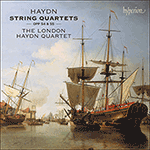
Welcome to Hyperion Records, an independent British classical label devoted to presenting high-quality recordings of music of all styles and from all periods from the twelfth century to the twenty-first.
Hyperion offers both CDs, and downloads in a number of formats. The site is also available in several languages.
Please use the dropdown buttons to set your preferred options, or use the checkbox to accept the defaults.

| The London Haydn Quartet» More |
There is certainly nothing remotely jokey about Op 55 No 2 in F minor, at least until the bouncy finale. The whole quartet charts the gradual ascendancy of F major over F minor. For the first time since Op 17 No 3 of 1771, Haydn begins a quartet with a variation slow movement, here a set of ‘double variations’ on two related themes, the second a radiant major-keyed transformation of the astringent F minor opening. The first violin holds absolute sway until the cello soars into its plangent tenor register in the final F major variation.
F minor returns with a vengeance in the Allegro second movement, a spiky, rebarbative piece, rigorously monothematic and twice making disquieting (rather than comic) capital from lengthy silences followed by a shift to the key a semitone higher. After the theme has been obsessively scrutinized in the fugal development, the compressed recapitulation plunges immediately into F major and stays there. F major is confirmed in the extraordinary third movement, a minuet for philosophers that begins as a grave colloquy for first violin and viola and gradually flowers into four parts. (Is this Haydn’s tribute to the introspective, intently polyphonic minuet in Mozart’s A major Quartet, K464?) F minor then makes its last appearance in the trio, as serious-minded in its motivic development as the minuet. The jig-like finale celebrates the runaway triumph of F major in another of Haydn’s monothematic sonata forms, irrepressible in its energy and enlivened by some playful imitative writing at the start of the development.
from notes by Richard Wigmore © 2017
En tout cas, il n’y a rien de vaguement cocasse dans l’op.55 nº 2 en fa mineur, au moins jusqu’au finale plein d’allant. L’ensemble du quatuor planifie l’ascendant progressif de fa majeur sur fa mineur. Pour la première fois depuis l’op.17 nº 3 de 1771, Haydn commence un quatuor avec un mouvement lent en forme de variations, ici des «doubles variations» sur deux thèmes apparentés, le second étant une éclatante transformation en majeur du début sévère en fa mineur. Le premier violon exerce son emprise absolue jusqu’à ce que le violoncelle s’élance dans son registre ténor retentissant pour la dernière variation en fa majeur.
Fa mineur opère un retour en force dans le second mouvement Allegro, revêche et rébarbatif, rigoureusement monothématique et qui tire parti à deux reprises et de façon inquiétante (plutôt que comique) de longs silences suivis d’un changement de tonalité un demi-ton plus haut. Après avoir examiné le thème minutieusement et de manière obsessionnelle dans le développement fugué, la réexposition condensée plonge immédiatement en fa majeur et y reste. Fa majeur est confirmé dans l’extraordinaire troisième mouvement, un menuet pour philosophes qui commence comme une grave conversation entre le premier violon et l’alto et s’épanouit peu à peu en quatre parties (est-ce un hommage de Haydn au menuet introspectif et extrêmement polyphonique du Quatuor en la majeur, K464, de Mozart?). Fa mineur fait ensuite sa dernière apparition dans le trio, aussi sérieux dans le développement des motifs que le menuet. Le finale en forme de gigue célèbre l’immense triomphe de fa majeur dans une autre de ces formes sonates monothématiques chères à Haydn, d’une énergie exubérante et animé par une écriture imitative enjouée au début du développement.
extrait des notes rédigées par Richard Wigmore © 2017
Français: Marie-Stella Pâris
Das Quartett f-Moll op. 55 Nr. 2 hat nicht Scherzhaftes an sich, jedenfalls nicht bis zum fröhlichen Finale. Das gesamte Quartett umreißt den allmählichen Aufstieg von f-Moll nach F-Dur. Zum ersten Mal seit seinem Quartett op. 17 Nr. 3 (1771) stellt Haydn einen langsamen Variationssatz an den Anfang; hier ist es eine Doppelvariation zweier miteinander verwandter Themen, deren zweites die strahlende Dur-Version des herben f-Moll-Anfangs darstellt. Hier dominiert die 1. Violine unangefochten, bis das Cello sich in der F-Dur-Schlussvariation in seine volltönende Tenorlage aufschwingt.
Mit Wucht kehrt die Molltonart im zweiten Satz, Allegro, zurück, einem dornigen, abweisenden Stück. Es ist strikt monothematisch und bezieht zweimal beunruhigende—nicht komische—Wirkung aus langen Pausen, nach denen die Musik einen Halbton höher fortfährt. Nachdem das Thema in der fugenartigen Durchführung erschöpfend erkundet worden ist, wendet sich die geraffte Reprise unvermittelt nach F-Dur, wo sie auch bleibt. Der außergewöhnliche dritte Satz bestätigt die F-Dur-Tonart. Dieses Menuett für Philosophen beginnt als strenges Zwiegespräch von Violine und Bratsche und fächert sich nach und nach auf vier Stimmen auf—möglicherweise eine Hommage an das introvertierte, dezidiert polyphone Menuett in Mozarts A-Dur-Quartett KV 464. Seinen letzten Auftritt hat f-Moll dann im Trio, dessen motivische Entwicklung ebenso ernsthaft wie die des Menuetts verhandelt wird. Das tänzerische Finale schließlich, im endlich gelöst triumphierenden F-Dur, bildet wiederum eine monothematische Sonatenform nach Haydns Manier. Mit unaufhaltsamer Energie drängt es voran, belebt von spielerisch imitierendem Satz zu Beginn der Durchführung.
aus dem Begleittext von Richard Wigmore © 2017
Deutsch: Friedrich Sprondel
 Haydn: String Quartets Opp 54 & 55 Haydn: String Quartets Opp 54 & 55More masterly Haydn from The London Haydn Quartet in this economically priced set of six great quartets from the late 1780s.» More |

